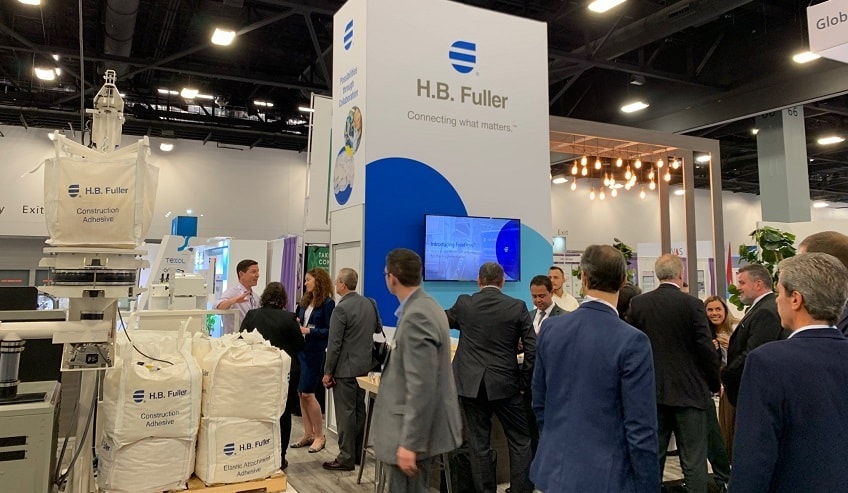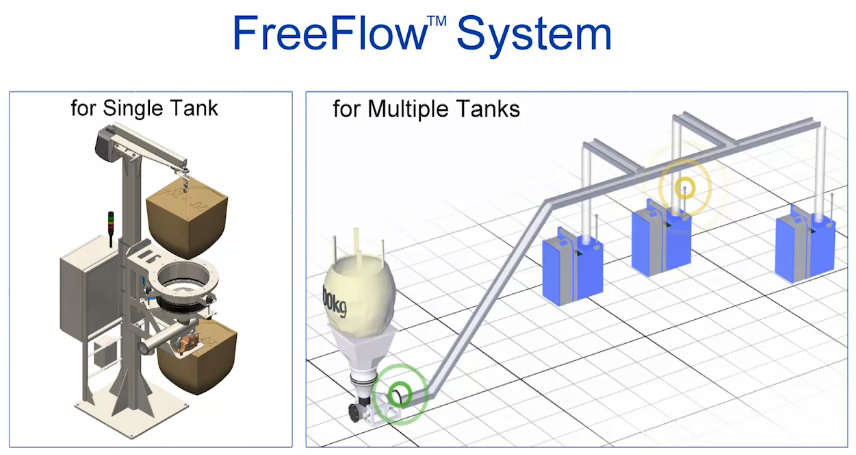
The Glue Talk Blog

Industry 4.0 is the current manufacturing trend of automating processes and exchanging data by way of technology. It is commonly referred to as the fourth industrial revolution because it uses cyber-physical systems, which is an advancement from the introduction of computers and automation during the third industrial revolution. By introducing Industry 4.0 solutions to their facilities, nonwovens manufacturers can make informed business decisions in real-time.
While attending IDEA, the world’s preeminent event for nonwovens and engineered fabrics, we launched our Industry 4.0 solution, FreeFlow™ Automated Adhesive Delivery System. This system was designed to handle adhesive pillows of Full-Care proprietary technology in large capacity supersacks. FreeFlow addresses key market trends that are affecting nonwovens manufacturers including:
- Labor: The manufacturing labor market is tight with more job openings than unemployed workers and a growing skills gap that may leave an estimated 2.4 million positions unfilled between 2018 and 2028. Labor costs also are affecting manufacturers across North America and Europe. FreeFlow’s simplified adhesive handling process reduces the number of employees required in the adhesive handling processes and allows them to focus on more value-added activities.
- Safety: Employers pay an estimated $1 billion per week for direct workers’ compensation costs. Injuries such as strains and burns can cost $30,000 to $45,000 per OSHA. With FreeFlow, operators are no longer exposed to molten adhesive when filling the tanks or required to lift heavy adhesive loads.
- Line efficiency: Adding adhesive to a tank that is low can cause a “shock” to the system. The wrong adhesive can mistakenly be loaded by an operator. These common occurrences can cause line inefficiencies, costing nonwovens manufacturers time and money. The automated on-demand feeding of FreeFlow maintains adhesive levels in the upper 80% and keeps production on track.
- Tank contamination: End users are becoming more aware of what goes into the products they use. In an effort to prioritize user safety and confidence, manufacturers must do their best to prevent contaminants during production. The closed delivery system of FreeFlow eliminates reoccurring opening and closing of the melt tanks for the adhesive refills, minimizing the risk of contamination.
“[FreeFlow] solves the problems of handling difficult drums and opening [adhesive] boxes,” Global Technical Service Manager Bill Pulanco shared with Nonwovens Industry. “It keeps the operator safe from dealing with hot adhesives, keeps contamination out of the system and offers cost savings.”
FreeFlow Configurations

Single Tank FreeFlow System
- Uses 100 kg supersacks
- Requires smaller footprint and capital investment
Multi-Tank FreeFlow System
- Uses 400 kg supersacks
- Feeds multiple tanks and lines
Unlike vacuum-feeding solutions, FreeFlow is more energy-efficient, quiet, and low maintenance. It can distribute various types of H.B. Fuller adhesives for multiple hygiene applications. The reliability of the FreeFlow system has proven to provide value to absorbent hygiene product manufacturers.
Contact your H.B. Fuller professional or Bill Pulanco. H.B. Fuller will work with you on a customized proposal to implement FreeFlow in your facility following the line audit.
How FreeFlow Works
Blog Categories
Blog Categories
Archive
- 2024
- 2023
- 2022
-
2021
- January (3)
-
February (7)
- Celebrating Exceptional Service During COVID-19 Complications
- Cyanoacrylates: What They Are and What They Do
- Innovative two-shot bookbinding adhesive
- Make a Difference 2020
- Problem Solving: Paper Straws in Drinking Beverages
- Stronger straws sustainable future
- Substances of Interest in Disposable Absorbent Hygiene Products
- March (4)
- April (4)
- May (4)
- June (5)
- July (2)
- August (5)
- September (2)
- October (1)
- November (3)
- December (2)
-
2020
- January (4)
- February (2)
- March (3)
- April (4)
- May (3)
-
June (7)
- Community Support in the Era of Coronavirus
- HBFuller Employee Creates Face Shields with 3D Printer
- Improved Packaging Integrity and Greater Customer Satisfaction
- Liquid-Resistant Paper Straws
- What is a Sealant?
- What Is the Future of Commercial Disinfectants?
- Winning over consumers with e-commerce packaging solutions
-
July (6)
- Employees Take Action to be Part of Healing and Growth
- Gain a competitive advantage with packaging adhesive solutions
- HB Fuller Company Foundations Commitment to Communities
- Packaging Solutions for the South African Agriculture Market
- Supporting Organizations That Provide STEM Education for Youth
- Where Does Sustainability Stand Amid COVID-19
- August (3)
- September (2)
- October (4)
- November (2)
- December (4)
